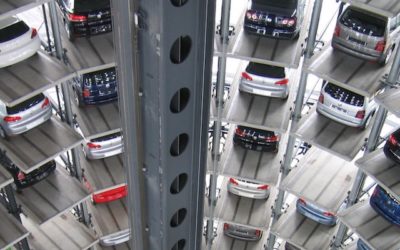AVs are coming… but we don’t have to wait
Many people are excited for autonomous vehicles, or AVs, to hit the streets. And given the benefits we’ve heard they could bring, it’s understandable. AVs have been touted as the solution to all sorts of transportation problems, from making our streets safer by eliminating human-caused accidents and drunk driving, to cutting down on pollution and congestion by using roads more efficiently. It’s even been claimed that there could be less need for parking in the future, freeing space in cities to be put to better uses. This great new future is coming, we’ve been told; we just need to wait.
But in fact, we might not need to wait at all. Much of the improvements we are hoping AVs will bring are actually available to us today. While it’s true that AVs could accelerate things when they arrive, we can get started on many upgrades to our transportation system now, while preparing to do more as new vehicle technologies are developed.
 Transportation as a Service
Transportation as a Service
Although much of North America has been developed to accommodate personal cars, it’s becoming easier in many places to live without owning a vehicle. Already common in dense, urban areas such as New York City, the car-free lifestyle is expanding in popularity with new, ultra-convenient options for ridehailing (such as Uber and Lyft), carsharing (such as ZipCar), and apps for planning mass transit journeys (such as Google Maps or Transit App).
This trend is great for cities in terms of providing accessibility to those who don’t drive, as well as dealing with parking limitations. Abandoning car ownership can also result in less overall travel, as consumers who pay by the ride are more sensitive to costs and careful in their trip choices. This can mean a reduction in congestion (and pollution and accidents), as well as significant savings on things like insurance, vehicle depreciation, and car loans – all sunk costs of ownership that accrue even while cars sit parked.
 Shared occupancy and first/last mile integration
Shared occupancy and first/last mile integration
If we really want to improve congestion and use roads more efficiently, though, the key is in something we already have and know well – mass transit. Nothing helps traffic problems more than grouping people who are headed along the same corridor together in the same vehicle or, even better, in a train. One commuter train can carry the same number of people as 1400 cars. But even things as simple as carpooling or taking buses instead of taxis can make a big difference for cities.
There are a lot of things we could do to improve mass transit, but one thing that will be vital will be to integrate it well with everything else. If ridehailing services can conveniently bring people to bus hubs and train stations, or pick people up together in shared vehicles (such as UberPOOL), both our road systems and our public transit systems will benefit. Again, this is the model we will need to move toward with AVs in the future anyway, so there’s no reason not to get working on incentive systems now that will help develop and improve integrated options for travelers.
 Electrification
Electrification
Pollution from vehicle operation has been a problem for over a century, and everyone is eager to see it go away with the adoption of new technology. It’s common to equate the move to AVs with a shift to electric vehicles, but the two are separate developments. There is no reason that AVs need to be electric, and indeed the most popular vehicles used for AV development and testing today are not. Luckily, electric vehicle development is also advancing quickly, and indeed already gaining market share. Continuing to encourage this is the second best thing we can do right now to reduce pollution from vehicle operation – the first being simply to help people drive less.
 Safety
Safety
Safety is often cited as the top reason to adopt more automation in our vehicles, and with over a million deaths each year due to human errors, it’s clearly an important goal. But even before vehicles drive themselves, manufacturers are already building in features that can assist human drivers and help to avoid some dangers. Vehicle systems that intervene before things go wrong can be implemented long before we give drivers the option to take their eyes off the road.
At the same time, reducing the number of accidents can be achieved in other ways, starting by simply reducing the amount of driving we do. By riding together (shared occupancy) and taking mass transit (first/last mile integration), fewer human drivers need to be on the road, which means fewer human errors. Also, with great alternative options from transportation service providers, people can choose not to drive when tired, distracted, or drunk. Taking drivers in these dangerous situations off the road would be an enormous improvement to road safety.
Even just changing our priorities about parking could influence safety. When people use alternatives to the private car, there is much less need for large parking lots around each destination. Without this need, cities can be built more densely with houses and workplaces and shopping much closer together. This way of building cities, which of course predates the automobile, makes for walkable places and means that much less driving is necessary for city inhabitants. Less driving again means less human errors, which means less accidents.
Getting where we want to go…
Autonomous vehicles certainly have the potential to accelerate each of these desired benefits. Many AVs are likely to be built as electric vehicles, especially as the first will be short range, special use vehicles such as shuttles and taxis. With AV fleets, companies that provide transportation as a service will be able to lower their costs, making their use even more attractive to customers. AVs will of course not be prone to human error, so each trip that gets made in an AV instead of a human-driven vehicle will make the roads just a little bit safer.
But it may be the area of shared occupancy and first/last mile connections that makes the biggest difference to the quality of life for most people. These types of trips certainly don’t need to involve automation to make a big impact, but the addition of AVs brings a big opportunity. If we are able to use the unique qualities of AVs to improve mass transit and incentivize less VMT, we could do more to improve our transportation problems than through all other methods combined.
Each of these benefits of AVs are worth planning for and working toward. But while we’re doing so, we can also be making the most of the opportunities that are available to us right now.
More Articles on Automated Vehicles:
The Surprising Downside to Driving
The car is the perfect transportation device. It takes me anywhere, anytime I want, effortlessly and fast…
read moreAVs might not be the biggest change coming to city transportation
AVs are being hailed as the solution to our transportation problems. But the biggest wins may lie elsewhere.
read moreWill AVs replace our cars?
Adding AVs versus taking away people’s cars: What we are likely to see in the coming years…
read more



